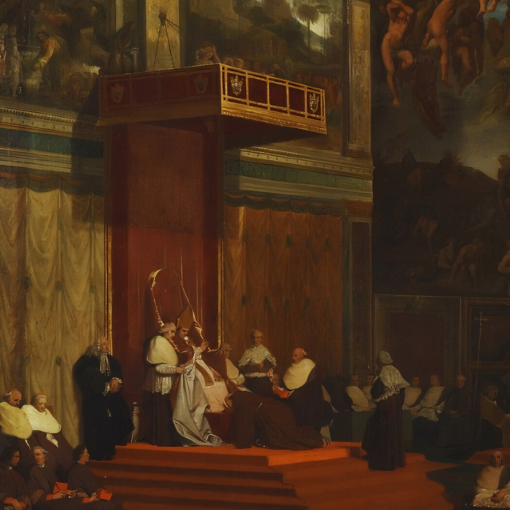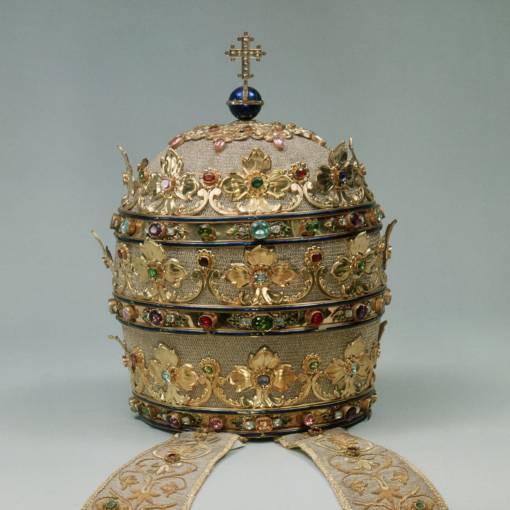Die 11 ianuarii Anno Domini 2024 Sancti Hygini Papæ et Martyris Sexta die infra Octavam Epiphaniæ
The last crowned pope was Paul VI. The liturgy took place in St. Peter’s Square on June 30, 1963 was unique not only because of the place of its celebration and the simplifications introduced in relation to the customary ceremony, but also because of the tiara with which the Bishop of Rome was crowned. To this day, the way this papal crown was made – in a simple and modern style – can raise the temperature of many discussions, also among experts of art and crafts. Undoubtedly, compared to the triple papal crowns used in earlier centuries, Paul VI’s tiara stands out both in terms of shape and decoration.

Source: Osservatore Romano.

Source: Osservatore Romano.
After the election of Cardinal Giovanni Battista Montini, Archbishop of Milan, to the Throne of Peter, it was decided that the solemn coronation of the new pope would take place on June 30, 1963, i.e. nine days after the world heard Habemus Papam! There is not much time to create an artistic work like a tiara, and this was the task faced by the members of the then famous Milanese School of Fra Angelico (Scuola Beato Angelico) – it was entrusted to them after the faithful from the Archdiocese of Milan wanted to donate and fund „their” pope new triple crown. Fragment of the article: What happened to the Papal Tiara?
On behalf of the faithful of the Archdiocese of Milan, the tiara was financed by the Municipal College of the Parishes of Milan (Collegio Urbano dei Parroci Milanesi). The work at the Fra Angelico School was intense, as evidenced by the preserved sketches and designs of Paul VI’s tiara. Nevertheless, the choice fell on the most modern and at the same time the most austere idea.


To this day, there are many joking terms with military connotations used in relation to Paul VI’s tiara. They are rather groundless and even absurd, despite the fact that the Cold War (1947-1991) was ongoing and the experience of two world wars (how could a tiara in the shape of a ballistic missile indicate the desire to pursue international peace?). According to another interpretation, the tiara was supposed to refer to the conquest of space (the first successful space flight took place in 1944, in 1957 the first satellite was placed in Earth’s orbit, and in 1961 the first man was sent into space). The work would be a symbol of the universality of the Church and the universality of Christ’s work of salvation. However, no such explication or exegesis can be found in any materials or publications devoted to the tiara of Paul VI.

Source: Liturgical Arts Journal / John Sonnen.

Source: Liturgical Arts Journal / John Sonnen.

Source: Liturgical Arts Journal / John Sonnen.
The tiara is made of silver-plated metal with a Florentine texture. In fact, it has not the traditional three, but four crowns: three golden bands set with precious gems and a band of 24 gold-plated metal lilies, each also with a jewel. The tiara is topped with a gilded cross. It also has the usual so-called vittae (ribbons) of silk trimmed with gold, decorated with pearls and finished with fringes – both have the coat of arms of Paul VI embroidered on them. The stones in the three golden stripes have non-random colors: the lower ones are white and symbolize faith, the middle ones are green and symbolize hope, and the highest ones are red and mean love. Moreover, the lilies used on the base refer to the lilies found in Montini’s coat of arms – together with white stones, they symbolize purity and refer to the palette of papal colors established in the Middle Ages (the Pope wears white because he is the Vicar of Christ himself on earth). Therefore, on the one hand, there are numerous references to the traditional canon, and on the other hand, there is an attempt to approach the topic innovatively from an artistic point of view.
Source: Scuola Beato Angelico, Milano.
However, as mentioned: Pope Paul VI’s tiara could have looked much different. Sketches created in June 1963 are kept in the archives of the Fra Angelico School in Milan (Scuola Beato Angelico). In addition to projects similar to the final one, ideas more rooted in tradition were also considered, but they were clearly less numerous. The sketches were presented in 2022 during the exhibition „Sacred Signs. One Hundred Years of the School of Fra Angelico” (Segni Sacri. I cento anni della Scuola Beato Angelico) organized at the ADI Design Museum in Milan.

Source: Chiesa di Milano. Il portale della Diocesi Ambrosiana.

Source: ChiesadiMilano / @chiesadimilano (YouTube).

Source: ChiesadiMilano / @chiesadimilano (YouTube).
We present a photo gallery of five sketches of Paul VI’s tiara from the Fra Angelico School, which were made by Nicola De Grandi from Milan during the Segni Sacri exhibition – thank you for sharing and agreeing to publish them. Here’s what Pope Paul VI’s tiara might have looked like:





The presented sketches indicate quite clearly that a specific shape of the tiara (wider bottom, oblong shape, four rows of crowns) was quickly decided on, departing from the baroque, but also historically justified and that more time was spent on refining the details (type of crowns, decorations, selection of precious stones, etc.). It can therefore be said that the artists from the Fra Angelico School implemented their own idea and consistently refined it for making the papal tiara – the last one used for the coronation of the Bishop of Rome.
RECOMMENDED VIDEOS
RECOMMENDED READINGS
- What happened to the Papal Tiara?, Caeremoniale Romanum, December 11, 2023.
- The Last Tiara Used in a Papal Coronation (Made by Scuola Beato Angelico in Milan), Liturgical Arts Journal, Februaru 9, 2022.
- A Moment in History: The Coronation Tiara of Pope Paul VI, Basilica of the National Shrine of the Immaculate Conception, Februaru 6, 2020.
- L’Osservatore Romano della Domenica, 7 Luglio 1963, n. 27 (1520) – La Tiara Pontificale sul capo di Paolo VI.





